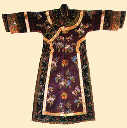 The organization of political power mainly consisted of the rulers of the Manchu ethnic minority in the Qing Dynasty (1644-1911), so the customs of Manchu bannermen affected those of the Central Plains. The traditional dress code that had been handed down for several thousand years was damaged because of the invasion of the Eight Banners soldiers. It might be said that this innovation was another improvement of China's traditional dress code. It was the third obvious revolution after the Mongol Costumes for Arrow Shooting on Horseback and the Open Dresses of the Tang Dynasty in the history.
The organization of political power mainly consisted of the rulers of the Manchu ethnic minority in the Qing Dynasty (1644-1911), so the customs of Manchu bannermen affected those of the Central Plains. The traditional dress code that had been handed down for several thousand years was damaged because of the invasion of the Eight Banners soldiers. It might be said that this innovation was another improvement of China's traditional dress code. It was the third obvious revolution after the Mongol Costumes for Arrow Shooting on Horseback and the Open Dresses of the Tang Dynasty in the history.
Since Qizhuang(costumes of bannermen) were convenient for dressing and cost fewer materials, they replaced the complicated ancient blouses and skirts. This was the main reason that later generations easily accepted the dressing style ofQizhuang.
TheQizhuangof Manchu ethnic minority looked rectangular, and the saddle-shaped collar could cover the cheek and protect the face. The costume had no waistline, and theirU-shaped sleeves with semicircle cuffs could cover the hands. The clothes were decorated with laces and a sleeveless jacket or a mandarin jacket could be worn over a gown. The solemn, respectful and morally lofty appearance ofQizhuangbroke away from tower-shaped clothes and hats. TheQizhuangcostume still has certain impacts on modern costume. Especially, along with the development of China, a cheongsam that demonstrates women's curvaceous beauty has become the representative garment of the Han people, as it can show the femininity and temperament of oriental ladies.
A cheongsam or a short coat had a lute-shaped front, a front with buttons on the right or a front of Chinese-style jacket with buttons down, etc. A skirt or a pair of trousers used to match a cheongsam was decorated with printing, embroidering, oblique seaming and other techniques. Women of Manchu ethnic minority neither bound their feet nor wore skirts. The sleeveless jacket (padded or lined) over the coat was of the same length as the coat, and within it there was a small underwear, which was equivalent to the bellyband worn by women of the Han people.
Combined Costumes in Different Periods:
During the reign of Emperor Kangxi, it was very popular for aristocratic women to wear a brown robe with a black collar, and golden round patterns or sheet golden patterns. They also wore adornments in front of their garments, a big wispy bun and a piece of headcloth on their head.
During the Qianlong reign, women wore a big black waistcoat over a buff coat inlaid with pink trims.
During the reigns of Jiaqing and Daoguang, women often wore a purple skirt and a blue upper garment with a low collar.
During the Tongzhi reign, laced ribbons made of blue satin were popular. Such ribbons were more than 3.3 meters long and were decorated with embroidered patterns at both ends. It was a common practice to wear all skirts and trousers with ribbons.
During the mid-term of the Guangxu reign, upper garments and skirts for women gradually became shorter and their sleeves, wider. The ribbons reached beyond the knees for more than a third of one meter. Most clothes were lake blue or pink, and some were aquamarine, bright red and so on.
Upper outer garments of women reached beyond the knees at the end of Guangxu reign. Some skirts were attached with 16 to 20 ribbons, with small silver bells tied at the end of every ribbon. Some gold or silver ornaments such as earpicks, toothpicks and small nippers were hung on the front part of garments.
It was popular to tailor false cuffs, generally 1-2 cuffs or 2-3 cuffs, inside sleeves at the end of the Qing Dynasty. This dressing style not only showed dignity and richness, but also strengthened the close style ofQizhuangcostume.
From the Xuantong reign to the early Republic of China, women's blouses and trousers became smaller and narrower than those at the end of the Guangxu reign, but the saddle-shaped collar became even higher as to cover the whole cheek.










